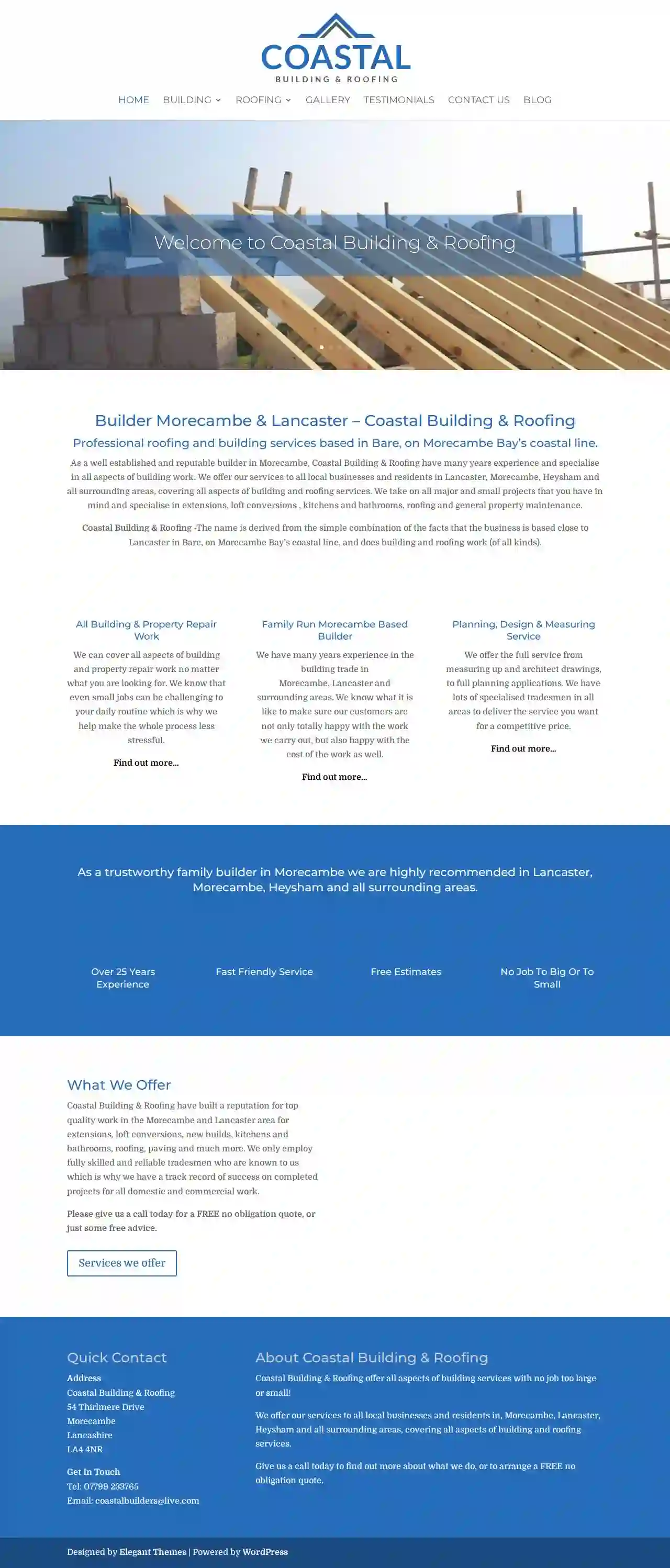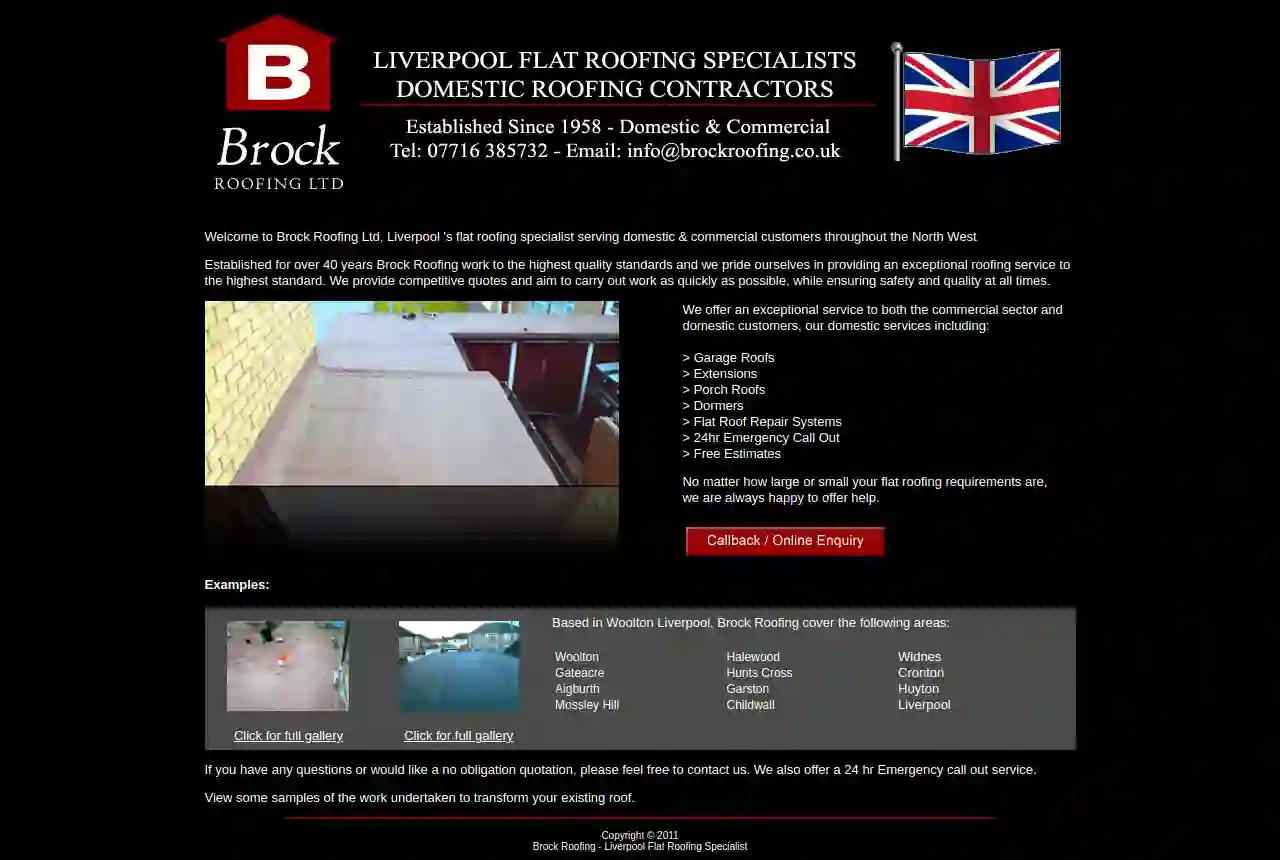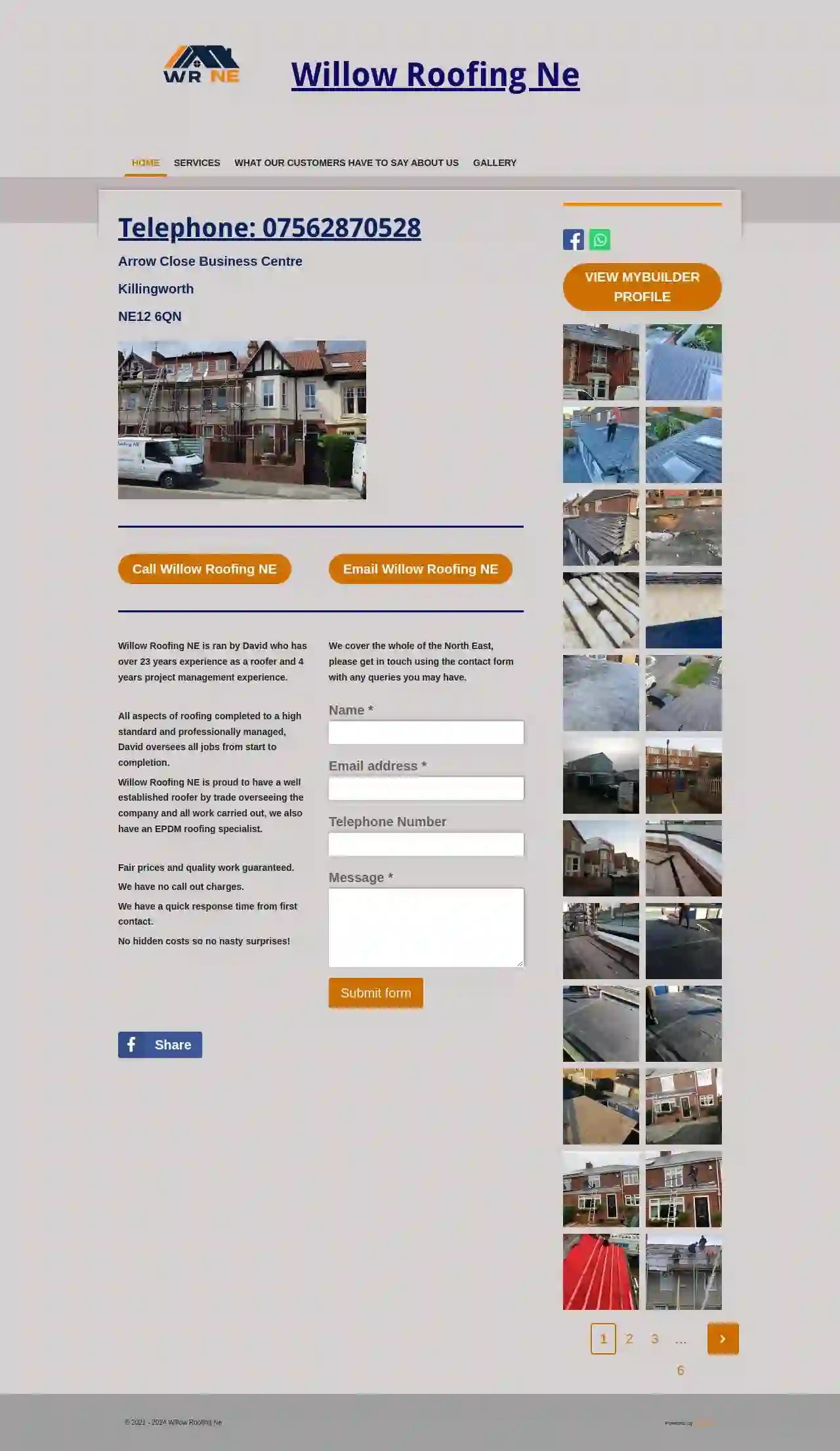Roof Leak Repair Blackpool
Best Stop Roof Leaks in Blackpool
Receive 3 FREE Stop Roof Leaks quotes for your project today! Compare profiles, reviews, accreditations, portfolio, etc... and choose the best service.

A1 Roofing Liverpool
2.33 reviews90e Burlington Street, Liverpool, L3 6DG, GBA1 Roofing Liverpool is a roofing services company based in Liverpool, Merseyside, UK. We offer a range of services including industrial roofing, fascia repair & replacement, tile roofing, shingle roofing, replacement tiles, and flat roofing. Our team is dedicated to providing 24-hour, seven-day-a-week roofing services to our clients in Liverpool and surrounding areas. We serve a diverse clientele, including consumers, firms, and enterprises, and are committed to delivering outstanding results. With our expertise and commitment to quality, you can trust A1 Roofing Liverpool to get the job done right.
- Services
- Why Us?
- Gallery
Get Quote
Coastal Building & Roofing
52 reviews54 Thirlmere Drive, Morecambe, LA4 4NR, GBCoastal Building & Roofing is a family-run business based in Bare, Morecambe, on the coastal line of Morecambe Bay. With over 25 years of experience, they are a well-established and reputable builder serving Morecambe, Lancaster, Heysham, and surrounding areas. They specialize in all aspects of building work, including extensions, loft conversions, kitchens and bathrooms, roofing, paving, and more. Coastal Building & Roofing prides itself on providing top-quality work, employing fully skilled and reliable tradesmen. They offer a full service, from measuring up and architect drawings to full planning applications. They are committed to customer satisfaction, ensuring both the quality of work and affordability. For a FREE no obligation quote or free advice, contact them today.
- Services
- Why Us?
- Gallery
Get Quote
Chris Moody Roofing
4.979 reviewsUnit 1 West Park View, Dudley, Cramlington, NE23 7AA, GBChris Moody Roofing and Building is a 'Checked and vetted' & 'Trading standards approved' family run business based in Wideopen, Newcastle. Trading since 2011, with over 15 years’ experience in the roofing and building trade. We specialise in all types of roofing and external building works. We pride Ourselves on our commitment to provide a Professional, Personal and Speedy service from quote to completion, whilst maintaining the highest quality of work and using top quality materials.
- Services
- Why Us?
- Accreditations
- Our Team
- Testimonials
- Gallery
Get Quote
The Tin Man | Metal Roofing Specialist
51 reviewsGBExpert Metal Sheet Roofing and Pressure Washing Services based in Lancaster, Morecambe and Surrounding Areas. The Tin Man prides itself on delivering top-quality metal sheet roofing and pressure washing solutions across Lancashire. With expertise and dedication, the Tin Man ensures your roofing needs and outdoor spaces are in safe hands. Quality Craftsmanship You Can Trust Attention to Detail in Every Project Experienced and Knowledgeable Solutions
- Services
- Why Us?
- Accreditations
- Our Team
- Testimonials
- Gallery
Get Quote
Right Choice Orangeries and Conservatories
4.741 reviewsAvant Garden Centre, A49 Wigan Road, Leyland, PR25 5XW, GBRight Choice is the North West’s only true specialist dedicated to the design, manufacture and installation of Orangeries, Conservatories and home extensions. They are also the home of the Garden Lounge solid tiled roof. Based in Leyland, they serve Preston, Chorley, Wigan, Bolton and Lancashire. Right Choice is a family run business who believe in quality, service and good old fashioned value for money. They don't sell windows, UPVC fascia boards, concrete garages, garden sheds, block paved drive ways or landscape gardening. They also don't build loft conversions, install fitted bedrooms or bathrooms. All their efforts are concentrated solely into producing the best Orangeries, Conservatories and home extensions possible. They have one of the largest display sites in the North West featuring 13 buildings so that you can see their quality and specification at close hand. They offer a variety of styles and sizes for you to browse. All are beautifully furnished in a range of interior styles to give you a feel of how one of their design and build installations would become part of your home and garden. Their orangeries and conservatories will provide you and your family with many years of enjoyment and relaxation, creating the perfect environment to suit your lifestyle.
- Services
- Why Us?
- Our Team
- Testimonials
- Gallery
Get Quote
Longsdale Roofing
GBLongsdale Roofing offer roofing services in Bolton le Sands, Carnforth, Silverdale, Arnside, Milnthorpe, Kirkby Lonsdale, Grange over Sands, South Cumbria to include Kendal, Windermere, Ambleside and the Lake District. Longsdale Roofing install new and repair flat roofs including garage and dorma roofs. Longsdale Roofing also provide chimney repairs, repair and renew fascias and roofline and install Velux windows. Domestic and Commercial Roofing Contractors. Storm damage and insurance work welcome. No VAT From a single slate to a whole new roof', Longsdale Roofing provide it all, offering a full range of roof repairs throughout South Cumbria and the Lake District. Longsdale Roofing provide a personal and professional service and all enquiries are dealt with quickly and politely. Longsdale Roofing provide all estimates and quotes in writing and all work is carried out professionally and safely.
- Services
- Why Us?
- Gallery
Get Quote
Brock Roofing
51 reviews100 Woolton Road, Liverpool, L25 7AA, GBWelcome to Brock Roofing Ltd, Liverpool's flat roofing specialist serving domestic & commercial customers throughout the North West. Established for over 40 years, Brock Roofing work to the highest quality standards and we pride ourselves in providing an exceptional roofing service to the highest standard. We provide competitive quotes and aim to carry out work as quickly as possible, while ensuring safety and quality at all times. We offer an exceptional service to both the commercial sector and domestic customers, our domestic services including: Garage Roofs Extensions Porch Roofs Dormers Flat Roof Repair Systems 24hr Emergency Call Out Free Estimates No matter how large or small your flat roofing requirements are, we are always happy to offer help. Examples: Based in Woolton Liverpool, Brock Roofing cover the following areas: Woolton Gateacre Aigburth Mossley Hill Halewood Hunts Cross Garston Childwall Widnes Cronton Huyton Liverpool Click for full gallery Click for full gallery If you have any questions or would like a no obligation quotation, please feel free to contact us. We also offer a 24 hr Emergency call out service. View some samples of the work undertaken to transform your existing roof. Copyright © 2011 Brock Roofing - Liverpool Flat Roofing Specialist
- Services
- Why Us?
- Gallery
Get Quote
Willow Roofing NE
59 reviewsArrow Close Business Centre, Killingworth, NE12 6QN, GBWillow Roofing NE is a roofing company run by David, who has over 23 years of experience as a roofer and 4 years of project management experience. We take pride in our well-established roofer and EPDM roofing specialist overseeing all work. We offer a range of services, including slating, tiling, full roof replacements, small repairs, roofline work, flat roofs, EPDM, leadwork, re-pointing, dry verge, dry ridge, solar panel removal and refitting, conservatory roof replacements, and Velux window fitting. We also offer cladding services. All our quotes are free of charge, and we'll discuss everything with you to give you peace of mind. We are professional from beginning to end. We cover the whole of the North East. Contact us using the form on the website for any queries.
- Services
- Why Us?
- Our Team
- Gallery
Get Quote
Best Choice Roofers LTD
4.945 reviews2 Clarendon Rd, Lancaster, LA1 2DQ, GBAt Best Choice Roofers we specialise in slate & tiled roofing, flat roofing, chimney repairs & guttering. We work through North Lancashire & South Cumbria, Contact us for a FREE No-Obligation Estimate! We are fully insured, and our work is guaranteed. We have over 65+ 5-star reviews on Google throughout North Lancashire & South Cumbria.We provide all aspects of roofing from new slate, tile and flat roofs to roof and chimney repairs, roofline accessories and more. If you need a roofer in North Lancashire or South Cumbria, you can get in touch with our team for a FREE, no-obligation estimate!
- Services
- Why Us?
- Gallery
Get Quote
North East Industrial Roofing Ltd
54 reviewsCrosby, GBWelcome to North East Industrial Roofing LTD, your trusted partner in roofing solutions. Established a decade ago by Craig Fowler, a seasoned professional with over 15 years of experience in the industry, we stand as a beacon of reliability and excellence in the roofing business.
- Services
- Why Us?
- Our Team
- Gallery
Get Quote
Over 12,314+ Roofing Businesses in our network
Our roofing experts operate in Blackpool and beyond!
Roofyng.co.uk has curated and vetted the Best Roofing Contractors arround Blackpool. Find a top & reliable business today.
Roof Leak Repair FAQs
- Recent Weather: If the leak appeared after recent heavy rain, snowfall, or a storm, it's likely a new leak.
- Water Stain Appearance: Fresh water stains are usually darker and more defined, while older stains tend to be lighter and more diffused.
- Mold or Mildew: The presence of mold or mildew indicates an older leak, as these take time to develop.
- Damage Extent: New leaks often show limited damage, while old leaks might have caused extensive rot or deterioration.
- Start in the Attic: Go into your attic during daylight and look for signs of water damage, like water stains, damp insulation, or mold.
- Follow the Trail: Follow any visible water stains or dampness upward to trace the leak's path.
- Inspect the Roof: From the outside, carefully inspect your roof for missing, damaged, or curled shingles, gaps in flashing, cracks around vents or chimneys, or any other visible damage.
- Check for Penetrations: Pay close attention to areas where objects penetrate the roof, such as vent pipes, chimneys, skylights, and dormers, as these are common leak points.
- Consider a Water Test: If the leak is elusive, a roofing contractor can perform a water test, spraying water on specific sections of the roof to pinpoint the source. If you're unable to locate the source or if the repair appears complex, it's best to call a professional roofing contractor for a thorough inspection and assessment.
- Regular Inspections: Inspect your roof at least twice a year for signs of damage, wear and tear, or debris buildup. Address any issues promptly.
- Gutter Maintenance: Keep gutters and downspouts clean and free-flowing to ensure proper drainage.
- Tree Trimming: Trim tree branches that overhang the roof to prevent damage from falling debris or branches rubbing against the roof surface.
- Proper Ventilation: Ensure adequate attic ventilation to prevent moisture buildup and reduce the risk of ice dams.
- Professional Inspections: Schedule a professional roof inspection every few years to detect and address potential problems early on.
How can I tell if a roof leak is new or old?
How do I find the source of a roof leak?
Can I fix a roof leak myself?
How can I prevent roof leaks from happening in the future?
How can I tell if a roof leak is new or old?
- Recent Weather: If the leak appeared after recent heavy rain, snowfall, or a storm, it's likely a new leak.
- Water Stain Appearance: Fresh water stains are usually darker and more defined, while older stains tend to be lighter and more diffused.
- Mold or Mildew: The presence of mold or mildew indicates an older leak, as these take time to develop.
- Damage Extent: New leaks often show limited damage, while old leaks might have caused extensive rot or deterioration.
How do I find the source of a roof leak?
- Start in the Attic: Go into your attic during daylight and look for signs of water damage, like water stains, damp insulation, or mold.
- Follow the Trail: Follow any visible water stains or dampness upward to trace the leak's path.
- Inspect the Roof: From the outside, carefully inspect your roof for missing, damaged, or curled shingles, gaps in flashing, cracks around vents or chimneys, or any other visible damage.
- Check for Penetrations: Pay close attention to areas where objects penetrate the roof, such as vent pipes, chimneys, skylights, and dormers, as these are common leak points.
- Consider a Water Test: If the leak is elusive, a roofing contractor can perform a water test, spraying water on specific sections of the roof to pinpoint the source. If you're unable to locate the source or if the repair appears complex, it's best to call a professional roofing contractor for a thorough inspection and assessment.
Can I fix a roof leak myself?
How can I prevent roof leaks from happening in the future?
- Regular Inspections: Inspect your roof at least twice a year for signs of damage, wear and tear, or debris buildup. Address any issues promptly.
- Gutter Maintenance: Keep gutters and downspouts clean and free-flowing to ensure proper drainage.
- Tree Trimming: Trim tree branches that overhang the roof to prevent damage from falling debris or branches rubbing against the roof surface.
- Proper Ventilation: Ensure adequate attic ventilation to prevent moisture buildup and reduce the risk of ice dams.
- Professional Inspections: Schedule a professional roof inspection every few years to detect and address potential problems early on.